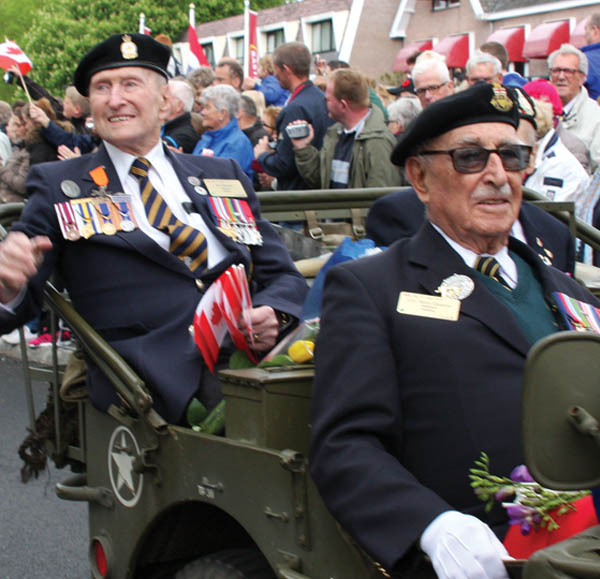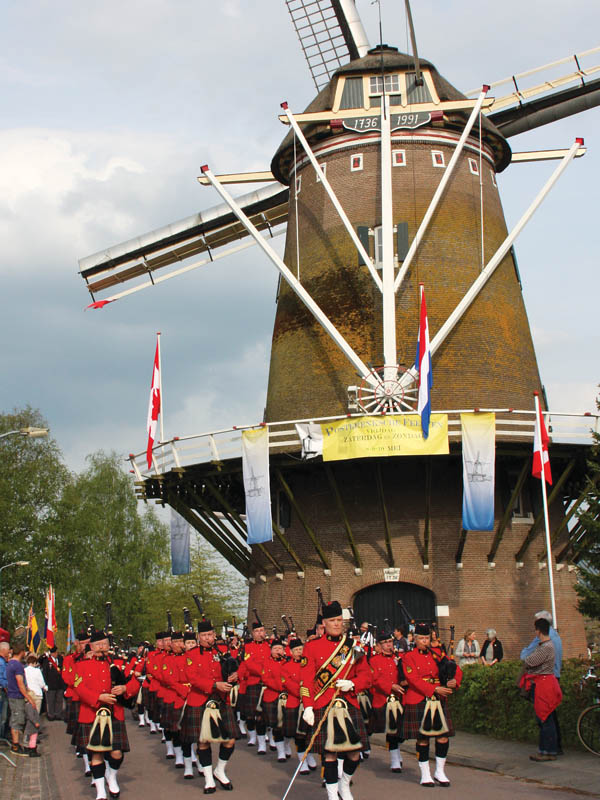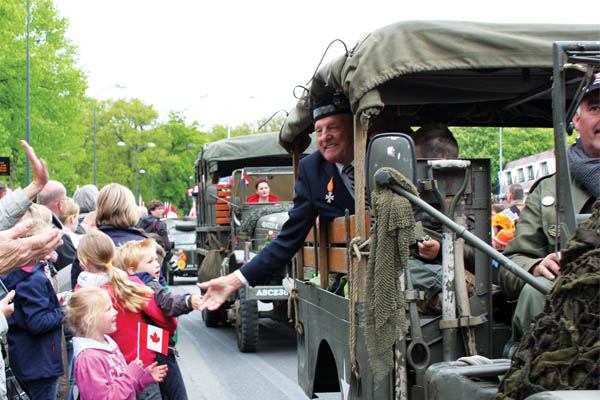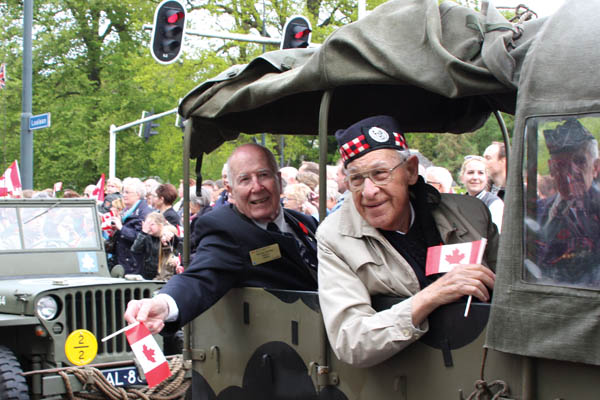Liberation Day in the Netherlands was as poignant as ever this year, despite the dwindling ranks of Canadian liberators

The celebration is joyful and slightly chaotic as the antique vehicles are slowed, then stopped, by the crowd attending the National Liberation Parade in Apeldoorn on May 9, at the end of a week of commemorations and festivities marking the 70th anniversary of the liberation of the Netherlands.
Burlington veteran Jim Warford is surprised, and then delighted, as a woman separates from the throng and takes advantage of the lull to give him a kiss. Ottawa’s Bud Hannam is unmindful of traces of lipstick on his cheek and by day’s end many veterans are carrying flowers—and sporting bruises from shaking hands with hundreds of people along the route.
“They…came over to our jeep to shake our hands, say thank you, give us flowers, chocolates, candies, souvenirs,” said George Chow of Vancouver. “They hugged and even kissed us.”
Dutch families took advantage of every opportunity to show their appreciation—perhaps for the last time—to the generation of Canadian soldiers that helped liberate northern and western Netherlands from German occupation near the end of the Second World War.
They crowded official events attended by the Dutch royal family—remembrance ceremonies at Groesbeek Canadian War Cemetery and Holten Canadian War Cemetery—as well as the Thank You Canadian Veterans parades at Wageningen and Apeldoorn. But they also participated in smaller events, including the burial at Bergen op Zoom of Private Albert Laubenstein, whose remains were only recently identified. And they partied with Canadians at more intimate festivities in small communities such as Posterenk, where two plaques are embedded in walls of the windmill in the town centre—one marking the year it was built, 1736, another marking the Canadian liberation of the town on April 13, 1945.
Although Dutch families enthusiastically proclaim they will continue to host Second World War liberators for as long as they come, the number of veterans able to make the trip had dwindled markedly from celebrations five years ago, while ranks of the frail swelled.
“In 2005, we spoke of the last visit to Netherlands, and once more in 2010,” said Apeldoorn Mayor John Berends at a medal ceremony for a dozen veterans visiting the city. “Now we’re at 2015. I should wisely not make such statements, [but] we’ll be here in five years.”

Each community celebrates its own remembrance day, for it took nine months of hard fighting, town to town, farm to farm, to break the Nazis’ grip on the country they had occupied for five brutal years. Nearly a quarter million Dutch died in concentration camps, by execution and acts of war, in forced labour and from starvation. The fight for liberation took 7,600 Canadian lives.
The national Remembrance Day is marked on May 4, while Liberation Day is celebrated on May 5, the date in 1945 on which Canadian General Charles Foulkes accepted the German surrender in the Netherlands at the Hotel de Wereld in Wageningen. Every five years since 1985, a larger week-long country-wide celebration, involving the royal family, heads of state and returning veterans, has been held to coincide with the national ceremonies.
This year, the celebrations, personal and public, were bittersweet: Dutch hosts were unwilling to say a final goodbye. Most veterans who attended are in their mid-90s.


“The children and grandchildren
will come. There must be found a way,
a will, to keep remembrance for always.”
Mayors of the cities that have hosted the five-year anniversaries are meeting to decide what future celebrations will entail, but the nature of the celebration has already begun to change. As Canadian liberators have died, Dutch families have segued to hosting veterans’ families. In increasing numbers, veterans’ children and grandchildren are signing up for liberation tours, such as that offered by Verstraete Travel and Cruises (which hosted this writer) and others. And they often bring along memorabilia.
Mary Hamilton and her brother John Welch of Minden, Ont., brought a remembrance album about their uncle Lyle Laverne Boice, a sergeant with the Stormont, Dundas and Glengarry Highlanders. Boice had many close calls during his four years in Europe. His ship was blown up on D-Day and he spent eight hours in the water before rescue. In France, a bullet shot off his beret. He was killed at the age of 22 in Nijmegen, along with two Dutch children, victims of a bomb.
Hamilton and Welch were billeted with a Dutch family by Welcome Again Veterans, which has arranged accommodations and commemoration programs for returning veterans and their families every five years since 1990. When their Apeldoorn host family, Trude and Ted Molenaar, told a friend they were hosting Boice’s relatives, “the friend said ‘That’s someone I do remember.’ And he put this whole scrapbook together for us,” said Hamilton. “This was a great opportunity for us to put some closure to all those years we heard about him,” said Welch. The pair visited Boice’s grave in Groesbeek Canadian War Cemetery.
Edwin Knox of Pincher Creek, Alta., also shared his father’s wartime story with the family with whom he was billeted. “My father, Tommy Knox, was a gunner on the big anti-aircraft guns on the coast of England, then followed on over to the continent. My little album details every bit of work they did through the whole duration.” Knox’s host family was able to enrich his understanding of his father’s experiences, and he was able to add to their knowledge of Canada and the Canadian war effort. Everyone, guest and host alike, absorbed and shared stories of those who lived the experience, helping to solidify memories into history.
“I remember a lot of people going hungry,” said Norman Gogo, who was serving with the Canadian Signal Corps near Apeldoorn at war’s end. The Hunger Winter began with Germany’s six-week ban on food shipments in response to a Dutch railway strike; but shipments continued to dwindle even after the ban due to damage to rail lines during the Allied advance and German requisitioning of supplies. “It was terrible. Children were begging for food. We were handing out our rations to the children. We were warned not to because we couldn’t get replacements, but we did it anyway.”
“In the early part of April 1945, we took food in,” remembered Charles Smith, an artillery driver seconded to the service corps, where he spent most of the war delivering ammunition to the front. “Our commander came down and said, ‘Put these white flags on the mirror. We’re going through the German lines with food.’ Just below Apeldoorn, we dumped it. The first load we dumped on the shoulder of the road—100 pounds of flour and 100 pounds of rice and sugar and cases of M&V [meat and vegetables] in cans. Then we went back for another load and another load and another. It went on for weeks.”
“At the end of the war, we had no food, we had no shoes and it was very cold,” said Valeska Goedkoop, 90, now of Apeldoorn. People lined up at the community kitchen for one ladle of watery soup each day, and “had to decide when to eat” their two slices of bread. She ate one for breakfast, “but the other one I saved until I was in bed,” where she savoured it crumb by crumb. The official daily ration per person was 320 calories at the time.
“It is just enough to die slowly,” neighbour Loes Sparrius read from a letter her great-uncle wrote to her grandparents Jan and Berta, asking for help. She is preserving their wartime letters, translating them from antiquated Dutch to share the stories with her children, grandchildren, nieces and nephews.
Sparrius’s grandfather had been in the radio business, and continued his trade surreptitiously after the occupation, when the Dutch were forbidden contact with the outside world. He would hide radios inside books or cigar boxes, trading them for food to distribute among neighbours.
He risked getting shot if caught, but the radios allowed people to listen to Queen Wilhelmina’s broadcasts from London. “She gave them courage to survive,” said Sparrius. And they needed it. Danger was everywhere, and freedom nowhere. Toward the end of the war, all healthy Dutch men were pressed to work in German factories. “My father was taken away and not heard from for six or seven months. Mother was at home with a new baby [Sparrius’s older sister]. That was a very awful situation,” she said. Everyone had a little suitcase packed, in case they had to flee at short notice.
“There was fear everywhere,” said Goedkoop, who still gets goosebumps whenever she hears the German language on a television program. “The feelings come back to me, the fear of it. It’s just as if I were there again. Seventy years later, it’s still there.”
Her family survived the war, though two friends were shot. After advising a Jewish man, her lawyer father was interned and forced to stand naked outside in the snow while those around him succumbed to the cold. Her eldest brother and his friends were in the local resistance. The family hid them at night in a hole hollowed out behind the central-heating unit. After the war, they discovered just how much they had risked: the young men had hidden their guns and ammunition in a cavity under the floorboards beneath the dining room table. “We would all have been shot if it had been discovered,” said Goedkoop.
She remembers vividly the relief flooding her body as she watched Canadian tanks arrive. “We heard by underground radio that the Canadians were in The Hague. We were at the side of the road for two days and two nights. You never forget that moment. Never, never, never. At last they came, and girls with them on the tanks. We were all so glad. It was the end of the war.”
“It’s not hard to realize why they’re so appreciative of Canadians,” said Gogo. “We saved lives. They are convinced more lives would have been lost if we hadn’t come in when we did.” Canada also provided refuge for the future queen, Juliana, and her daughters, one of whom, Margriet, was born in Ottawa.
Apeldoorn was liberated on April 17. “It was very short-lived,” said Gogo, “because the Germans got out as fast as we got in.” By noon, the town was secure; the Royal Canadian Regiment was in the town square and the Hastings and Prince Edward Regiment was on the grounds of Het Loo Palace, the royal residence. Canadian soldiers were welcomed with open arms then—and veterans and their relatives are still being welcomed 70 years later.
The celebrations were bittersweet:
Dutch hosts were unwilling to say a final goodbye.
Chris and Thea Van De Kamp first hosted veteran Earl Stiles a decade ago, and this year they welcomed Earl’s son, Jim Stiles, and his wife, Jeanette Frigault. They hope to do the same five years from now, plus make visits back and forth. The Van De Kamps are passing along the tradition to their grandchildren, three of whom helped with the Welcome Again arrangements this year, even driving hours to pick veterans up at the airport.
Jolanda Butytenhuis hosted Tom Gatenby in 2000 and 2005, and their families travelled together to Belgium and Normandy for the 60th anniversary of D-Day in 2004. After Gatenby died in 2005, Butytenhuis spread some of his ashes in Holten Canadian War Cemetery. She has continued to welcome his family. “After the veteran has gone, many host families continue to have Canadian families over,” she said. “You keep in touch as long as possible. In five years, I hope to host another Canadian.”
“I know I’ll be back, because I have a Dutch family now,” said Judy Le Craw. Her father, John Le Craw, 92, of Norland, Ont., has attended many of the five-year celebrations. The Le Craws have returned the favour for members of their host family, who have visited Canada several times, including attending the wedding of Judy’s sister.


Wartime stories are being perpetuated in Canada and Holland, generation to generation, through memories of veterans to siblings and offspring, grandchildren and great-grandchildren. Generations of boys in Hamilton’s and Welch’s families and community have been named Lyle in memory of Boice.
The friendship between the Netherlands and Canada is also perpetuated through public and personal friendships. Apeldoorn has been twinned with Burlington, Ont. The 180-member Burlington Teen Tour Band enthusiastically performed at parades in May, and eagerly talked to veterans and Dutch wartime survivors and made friends with Dutch students—friendships now easier than ever to maintain, thanks to social media.
But Sparrius worries. “I’m afraid the younger generation doesn’t have the same feeling,” she said. “Being told stories about relatives who were in the war doesn’t compare with stories from history you weren’t part of. But I think [the commemoration] will continue every five years. The children and grandchildren will come. There must be found a way, a will, to keep remembrance for always.”
Knox says the Dutch have done a good job passing the torch. “The sincerity of the Dutch is strong today, perhaps even stronger than it was 30 or 40 years ago in some ways,” he said. Dutch schoolchildren are steeped in war and liberation history. Many are assigned graves of Canadian war dead to tend. Children place wreaths at the ceremonies at Holten and Groesbeek, and every Christmas Eve, children are at the centre of a candlelight ceremony at Holten Canadian War Cemetery.
Sadly though, says Gerard Hendriks, president of The Royal Canadian Legion Branch in the Netherlands, the Dutch recognize that this year “will be the last time that the liberation of the Netherlands with our liberators will be celebrated in this format.”
Advertisement












